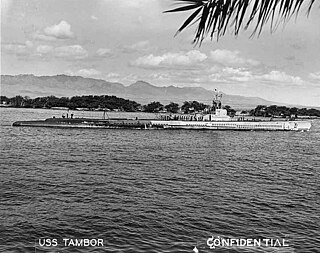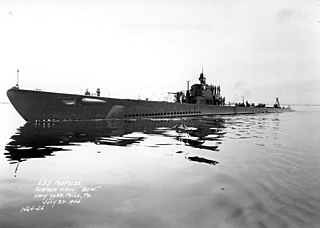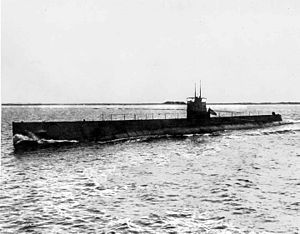
The Gato class of submarines were built for the United States Navy and launched in 1941–1943. Named after the lead ship of the class, USS Gato, they were the first mass-production U.S. submarine class of World War II.

The first USS Chicago was a protected cruiser of the United States Navy, the largest of the original three authorized by Congress for the "New Navy" and one of the U.S. Navy's first four steel ships.

USS Barracuda (SF-4/SS-163), lead ship of her class and first of the "V-boats," was the second ship of the United States Navy to be named for the barracuda.

The Balao class was a design of United States Navy submarine used during World War II, and with 120 boats completed, the largest class of submarines in the United States Navy. An improvement on the earlier Gato class, the boats had slight internal differences. The most significant improvement was the use of thicker, higher yield strength steel in the pressure hull skins and frames, which increased their test depth to 400 feet (120 m). Tang actually achieved a depth of 612 ft (187 m) during a test dive, and exceeded that test depth when taking on water in the forward torpedo room while evading a destroyer.

USS Bonita (SF-6/SS-165), a Barracuda-class submarine and one of the "V-boats," was the third ship of the United States Navy to be named for the bonito. Her keel was laid down by the Portsmouth Navy Yard. She was launched on 9 June 1925 as V-3 (SF-6), sponsored by Mrs. L.R. DeSteiguer, wife of Rear Admiral DeSteiguer, and commissioned on 22 May 1926, Lieutenant Commander Charles A. Lockwood, Jr. in command. Like her sisters, Bonita was designed to meet the fleet submarine requirement of 21 knots (39 km/h) surface speed for operating with contemporary battleships.

USS Marlin (SS-205), a Mackerel-class submarine, was the first ship of the United States Navy to be named for the marlin, a large game fish. Marlin and her near-sister Mackerel were prototype small submarines, which the Navy was exploring to replace the aging S-class submarines. References differ as to whether Marlin had a direct drive propulsion system or diesel-electric drive.

The V-boats were a group of nine United States Navy submarines built between World War I and World War II from 1921 to 1934 under authorization as the "fleet boat" program.

USS Bass (SF-5/SS-164), a Barracuda-class submarine and one of the "V-boats", was the first ship of the United States Navy to be named for the bass.

USS Cachalot (SC-4/SS-170) was a United States Navy submarine and the lead ship of her class, known as the "V-boats" and named for the sperm whale. Her keel was laid down by the Portsmouth Navy Yard. She was launched on 19 October 1933 as V-8 (SC-4) sponsored by Miss K. D. Kempff, and commissioned on 1 December 1933 with Lieutenant Commander Merril Comstock in command. Cachalot was the first submarine to have the Torpedo Data Computer, Arma Corporation's Mark 1, installed.

The Tambor-class submarine was a United States Navy submarine design, used primarily during World War II. They were the USN's first fully successful fleet submarine, and began the war close to the fighting. Six of the class were in Hawaiian waters or the Central Pacific on 7 December 1941, with Tautog at Pearl Harbor during the attack. They went on to see hard service; seven of the twelve boats in the class were sunk before the survivors were withdrawn from front-line service in early 1945; this was the highest percentage lost of any US submarine class. Tautog was credited with sinking 26 ships, the largest number of ships sunk by a US submarine in World War II. The Tambors attained the top speed of 21 knots (39 km/h) and range of 11,000 nautical miles (20,000 km) of the preceding Sargo class, and improvements included six bow torpedo tubes, a more reliable full diesel-electric propulsion plant, and improved combat efficiency with key personnel and equipment relocated to the conning tower. In some references, the Tambors are called the "T Class", and SS-206 through SS-211 are sometimes called the "Gar class".

The Sargo-class submarines were among the first United States submarines to be sent into action after the Japanese attack on Pearl Harbor, starting war patrols the day after the attack, having been deployed to the Philippines in late 1941. Similar to the previous Salmon class, they were built between 1937 and 1939. With a top speed of 21 knots, a range of 11,000 nautical miles (20,000 km), and a reliable propulsion plant, along with the Salmons they were an important step in the development of a true fleet submarine. In some references, the Salmons and Sargos are called the "New S Class", 1st and 2nd Groups.

The Clemson class was a series of 156 destroyers which served with the United States Navy from after World War I through World War II.

The United States Navy Salmon-class submarines were an important developmental step in the design of the "fleet submarine" concept during the 1930s. An incremental improvement over the previous Porpoise class, they were the first US submarine class to achieve 21 knots with a reliable propulsion plant, allowing them to operate with the Standard-type battleships of the surface fleet. Also, their 11,000 nautical miles (20,000 km) unrefueled range would allow them to operate in Japanese home waters. These rugged and dependable boats provided yeoman service during World War II, along with their immediate successors, the similar Sargo class. In some references, the Salmons and Sargos are called the "New S Class", 1st and 2nd Groups.

The Porpoise class were submarines built for the United States Navy in the late 1930s, and incorporated a number of modern features that would make them the basis for subsequent Salmon, Sargo, Tambor, Gato, Balao, and Tench classes. In some references, the Porpoises are called the "P" class.

USS M-1 (SS-47) was a unique submarine of the United States Navy. Although built as a fully operational boat, M-1 was built with a radically different double-hulled design. This was in marked contrast to Simon Lake's and Electric Boat's single-hulled concepts. Ultimately shown to be unsuccessful, no other submarines of this class were built, although future advances in construction and metallurgy science made the double hull design a standard one for the USN.

The Cachalot-class submarines were a pair of medium-sized submarines of the United States Navy built under the tonnage limits of the London Naval Treaty of 1930. They were originally named V-8 and V-9, and so were known as "V-boats" even though they were unrelated to the other seven submarines constructed between World War I and World War II. An extensive study was conducted to determine the optimum submarine size under the treaty restrictions, factoring in total force, endurance, and percentage of the force that could be maintained on station far from a base, as in a Pacific war scenario. Joseph W. Paige of the Navy's Bureau of Construction and Repair (BuC&R) developed the basic design, but the builder, Electric Boat, was responsible for detailed arrangement; this was fairly bold, since Electric Boat had not built any new submarines since finishing four obsolescent boats for Peru. The previous V-boats were all built in naval shipyards. Cuttlefish was the first submarine built at EB's facility in Groton, Connecticut; construction of previous Electric Boat designs had been subcontracted to other shipyards, notably Fore River Shipbuilding of Quincy, Massachusetts.

The first USS Nevada, a monitor, was ordered on 4 May 1898. She was awarded to the Bath Iron Works, Bath, Maine on 19 October 1898 and laid down as Connecticut, 17 April 1899. Connecticut was launched 24 November 1900; sponsored by Miss Grace Boutelle; renamed Nevada, January 1901; and commissioned on 5 March 1903, Commander Thomas B. Howard in command. The total cost for the hull, machinery, armor and armament was $1,851,313.22.

The 3"/50 caliber gun in United States naval gun terminology indicates the gun fired a projectile 3 inches (76 mm) in diameter, and the barrel was 50 calibers long. Different guns of this caliber were used by the U.S. Navy and U.S. Coast Guard from 1900 through to 1990 on a variety of combatant and transport ship classes.

The United States L-class submarines were a class of 11 coastal defense submarines built 1914–1917, and were the most modern and capable submarines available to United States Navy when the country entered World War I. Despite being considered a successful design by the USN, war experience in European waters demonstrated that the boats lacked the range, speed, and endurance to conduct extended patrols in the North Atlantic.

The 3"/23 caliber gun was the standard anti-aircraft gun for United States destroyers through World War I and the 1920s. United States naval gun terminology indicates the gun fired a projectile 3 inches (76 mm) in diameter, and the barrel was 23 calibers long



















